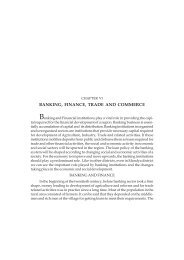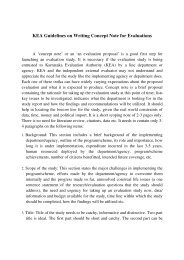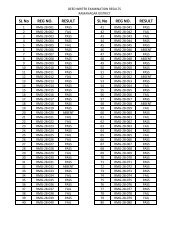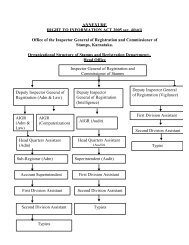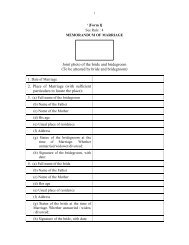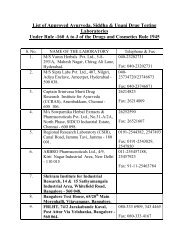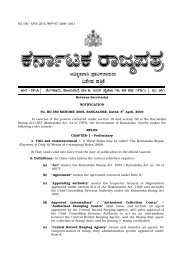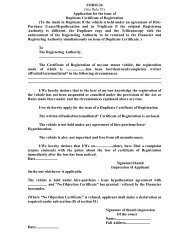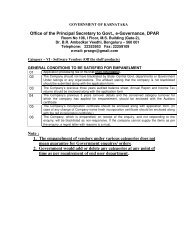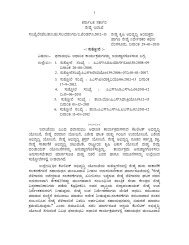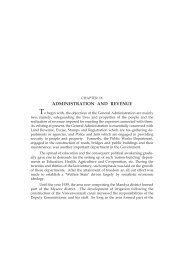Chapter XIII CULTURE - Government of Karnataka
Chapter XIII CULTURE - Government of Karnataka
Chapter XIII CULTURE - Government of Karnataka
You also want an ePaper? Increase the reach of your titles
YUMPU automatically turns print PDFs into web optimized ePapers that Google loves.
A Handbook <strong>of</strong> <strong>Karnataka</strong> 506<br />
Amateur theatre was the theatre <strong>of</strong> the educated people. It catered people<br />
<strong>of</strong> refined tastes and it has variety in subjects. Kalidasa’s Shakuntala was<br />
translated into Kannada by Basavappa Shastri in the Mysore court. These plays<br />
required educated artistes. This movement helped in bringing to light more and<br />
more educated Amateurs. In 1909, Amateur Dramatic Association (A.D.A.) was<br />
started in Bangalore, Bharata Kalottejaka Sangha (1904) in Dharwad, Young<br />
Men’s Football Association <strong>of</strong> Gadag etc.,<br />
The movement got a fillip in the second decade <strong>of</strong> the 20th Century when Kailasam<br />
(Bangalore) and Narayanrao Huilgol (Gadag) Samsa (Venkatadri Iyer) wrote their<br />
first original plays. To begin with, they were a protest against the melodramatic<br />
commercial theatre. Secondly, they touched current social problems; and thirdly,<br />
they did away with music, dance and irrelevent comedy. Kailasam was a genius<br />
with his ready wit. Vasudeva Vinodini Sabha, Kannada Amateurs etc., were<br />
the new groups. There were playwrights like Ksheerasagar, A.N. Krishna Rao,<br />
Parvatavani, Kaiwar Raja Rao, Sri Ranga and others. In the earlier years, the<br />
amateur theatre was mostly a theatre to be heard. The amateur theatre was<br />
a protest against the artificiality <strong>of</strong> pr<strong>of</strong>essional theatre. The language <strong>of</strong> the<br />
dialogues was as near the colloquial style as the pompous, artificial dramatic<br />
rhetoric <strong>of</strong> the commercial theatre was farther from it. It was this which brought<br />
about an intimacy between an audience and the play. After Independence,<br />
amateur theatre saw a spurt <strong>of</strong> activity. Academies were established, subsidies<br />
were granted, drama festivals were conducted and compititions were arranged.<br />
National school <strong>of</strong> Drama established in Delhi trained some aspirants from<br />
<strong>Karnataka</strong> along with others. Sri Ranga introduced them to the Kannada<br />
amateur theatre. In the commercial theatre the audience used to watch a great<br />
actor or listen to a great singer in that particular troupe but in the case <strong>of</strong><br />
amateur theatre they went to watch the play itself. Thus, the need for a capable<br />
director was felt. Talented directors like B.V. Karanth, came into the limelight.<br />
The latter part <strong>of</strong> the twentieth century was a period <strong>of</strong> assimilation <strong>of</strong><br />
various Western ideas on theatre and following some <strong>of</strong> their practices regarding<br />
theoritical activity. Due to these inputs, contemporary theatre movement gained<br />
momentum. In 1945, Parvathavani’s ‘Bahaddur Ganda’ (a transcreation) was<br />
staged 150 times continuously in which child prodigy Yamuna Murthy, the first<br />
lady artiste to appear on the Amateur Stage, played the lead role. Among the<br />
playwrights <strong>of</strong> the romantic period, Sriranga and G.B.Joshi could understand<br />
the new wave <strong>of</strong> theatres and wrote plays accordingly, and this happened after<br />
1955, the reason being a change <strong>of</strong> outlook with the advent <strong>of</strong> freedom to the<br />
country.<br />
Among the playwrights Girish Karnad, Lankesh, Chandrashekara Patil,<br />
Chandrashekara Kambara, B.C. Ramachandra Sharma, A.K. Ramanujan,<br />
Keertinatha Kurthakoti, N.Ratna and Puchante are the important people<br />
who contributed to the movement. New directors like B.Chandrashekar,<br />
B.V.Karanth, M.S.Nagaraj, K.V. Subbanna and N.Ratna rose to the occasion,<br />
plays like ‘Yayati’, Tughlaq’, ‘Kelu Janamejaya’, Teregalu’, ‘Jokumaraswamy’,<br />
‘Appa’, ‘Kunta Kunta Kutuvatti’, ‘Neelikagada’, ‘Neralu’ ‘Brahmarakshasa’,<br />
‘Ellige’, ‘Yamala Prashne’ etc., are important and popular even to this day.



